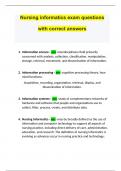Nursing informatics exam questions
with correct answers
1. Information science - ans -interdisciplinary field primarily
concerned with analysis, collection, classification, manipulation,
storage, retrieval, movement, and dissemination of information.
2. Information processing - ans -cognitive processing theory, how
mind functions.
Acquisition, recording, organization, retrieval, display, and
dissemination of information.
3. Information systems - ans -study of complementary networks of
hardware and software that people and organizations use to
collect, filter, process, create, and distribute data.
4. Nursing informatics - ans -may be broadly defined as the use of
information and computer technology to support all aspects of
nursing practice, including direct delivery of care, administration,
education, and research. The definition of nursing informatics is
evolving as advances occur in nursing practice and technology;
, there have been many different definitions throughout the years
as the discipline has evolved.
Nursing informatics is a specialty that integrates nursing science,
computer science, and information science to manage and
communicate data, information, knowledge and wisdom into nursing
practice.
Nursing informatics facilitates the integration of data, information,
knowledge and wisdom to support patients, nurses, and other
providers in their decision making in all roles and settings.
This support is accomplished through the use of information structures,
information processes, and information technology.
5. Data - ans -collection of numbers, characters, or facts that are
gathered according to some perceived need for analysis and
possibly action at a later point in time.
Examples of data include a client's vital signs.
Other examples of data are the length of hospital stay for each client;
the client's race, marital status, or employment status; and next of kin.
Sometimes these types of data may be given a numeric or alphabetic
code.
A collection of data can be examined for patterns and structure that
can be interpreted.
6. Information - ans -is data that have been interpreted.
Example, individual temperature readings are data.
, When they are plotted onto a graph, changes in the client's
temperature over time and comparison with normal values become
evident, thus turning into information.
7. Data and information are collected when nurses record the
following activities: - ans -• initial client history and allergies
• initial and ongoing physical assessment
• vital signs such as blood pressure and temperature
• response to treatment
• client response and comprehension of educational activities
8. Knowledge - ans -is the synthesis of information derived from
several sources to produce a single concept or idea.
Based on a logical process of analysis and provides order to thoughts
and ideas and decreases uncertainty.
Dynamic and derives meaning from its context.
Validation of information provides knowledge that can be used again.
Historically, nursing has acquired knowledge through tradition,
authority, borrowed theory, trial and error, personal experience, role
modeling, reasoning, and research.
Current demands for safer, cost-effective, quality care require evidence
of the best practices supported by research.
, 9. Example of knowledge - ans -can be seen in the determination of
the most effective nursing interventions for the prevention of skin
breakdown.
If a research study produces data related to the prevention of skin
breakdown achieved through specific interventions, these data can be
collected and analyzed.
The trends or patterns depicted by the data provide information
regarding which treatment is more effective than others in preventing
skin breakdown.
The validation of this information through repeated studies provides
knowledge that nurses can use to prevent skin breakdown in their
clients.
10. Information technology (it) - ans -management and
processing of information with the assistance of computers.
Computers and it provide tools that aid data collection and the analysis
associated with research to support the overall work of nurses.
11. Wisdom - ans -occurs when knowledge is used appropriately
to manage and solve problems.
It results from understanding and requires human effort.
The trip from data to wisdom is neither automatic nor smooth.
Comes from cumulative experiences, as the result of learning skills and
ways of thinking that can be viewed as predecessors to wisdom, and via
the creation of conditions that help participants to use their
accumulated knowledge effectively.




